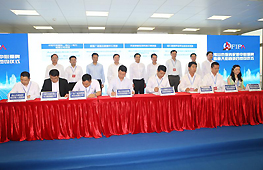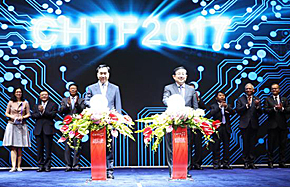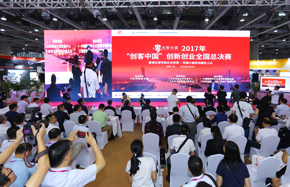Shenzhen maintains edge and ramps up funding for scientific R&D
Huang Kai joined the Shenzhen Bay Laboratory, or SZBL, a newly established government-backed institute that focuses on the development of the biochemistry sector from fundamental research to transformative achievement potential, in 2020.
The 33-year-old postdoctoral researcher, whose studies took place at Northwestern University in the United States, is working on a type of software capable of stimulating DNA folding in a three-dimensional space. He believes that China is in great need of advanced biochemical calculation software, according to a report from Economic Daily.
"Neither universities nor companies can develop the software independently because it's hard for the universities to produce papers and it takes too much time for companies to generate profits," Huang told the Beijing-based newspaper. "Only new-style research institutes like SZBL can undertake the tasks. That's why I chose Shenzhen."
Shenzhen, a Chinese vanguard in reform and opening-up located in South China's Guangdong province, has set a goal to become a city of innovation and creativity with global influence, according to Wang Weizhong, Party secretary of the city.
The city is home to a group of world-leading high-tech companies such as telecommunications giant Huawei Technology, internet company Tencent, medical device provider Mindray, new energy vehicle manufacturer BYD and commercial and civilian drone developer DJI.
Research, industry and talent should be interactively connected and supported in the systematic project of innovation, Economic Daily quoted Wang as saying.
He noted the city has advantages in its industrial system and innovation environment, but the integrity and synergy of the industry must be improved.
To enhance innovational capability from the very beginning would be a decisive move that could lead to an apparent advantage in the competition, Wang said, adding that the city will develop fundamental research and applied basic research.
"We have learned from experience that only by embracing key and core technologies can we take control of the initiative of innovation and development," Wang said when addressing the root technical problems.
The city government has allocated at least 30 percent of the city-level scientific development and research funds to fundamental and applied basic research since 2018, Wang said. The proportion was fixed through a local law in 2020.
As a result, the city's fiscal inputs in these types of research reached 2.8 billion yuan ($433.4 million) and 4.8 billion yuan in 2018 and 2019 respectively, accounting for 30 percent and 37.2 percent of the city-level funds that went to the research and development sector. In 2020, the amount increased to nearly 5 billion yuan, representing 42.7 percent of the city-level expenditure on R&D, official data show.
The total investment in R&D from all channels in Shenzhen surged from 73.2 billion yuan in 2015 to 136 billion yuan last year. The figure in 2020 accounted for 4.9 percent of its GDP, a level equal to or even better than some developed countries.
According to a government mid-to-long-term plan for 2025-35, issued on June 9, the R&D investment in Shenzhen is projected to be further raised to 200 billion yuan in 2025, accounting for 5 percent of its GDP.
"The dynamic innovation system and generous financial inputs of Shenzhen allow scientists to explore freely to their hearts' content," said Hu Xiaojun, Party secretary of SZBL.
More than 60 high-level laboratories and R&D institutes as well as more than 2,700 innovational platforms and entities have been set up in Shenzhen, according to official statistics.
Meanwhile, the city, though facing a land shortage problem to prop up further industrial development, has designated the best locations to build universities and scientific parks.
The young city, which was officially established in 1979, opened its first university in 1983. Now a couple of domestically leading universities, including Peking University and Tsinghua University, have set up campuses for graduate schools in Shenzhen.
Together with some new universities, a total of 15 colleges and universities operate in the city with about 113,200 full-time students. The city is expected to add an additional five universities in the next five years to establish a stronger reserve of talent, according to the government plan.
The latest rankings for young universities by Times Higher Education show, Southern University of Science and Technology, also known as SUSTech, founded in 2010 in Shenzhen, has entered the top 30 in the world and placed first on the Chinese mainland.
Xu Zhenghe, dean of College of Engineering at SUSTech, said the research-based university has developed a flexible system to encourage innovation of the faculties.
They are allowed to work on their technological research and practices outside the university one day every week, Xu said.
The scientific achievements of the faculties can be priced in shares in a company so that the faculties, the university and the company can all enjoy the benefits of the cooperation, he added.
Wu Delin, Party secretary of the Shenzhen campus of Harbin Institute of Technology, said the school has set up more than 60 laboratories together with a group of famous companies, including Tencent, telecommunications leader ZTE and BGI, a world leading life science and genomics organization. Meanwhile, it has built industry research bases with another 60 companies.
The university has opened its large-scale instruments and equipment to the companies and solved more than 1,400 technical problems for them, Wu said.
Members of the Communist Party of China have also played an important role in innovative research in Shenzhen.
Teng Chao, a distinguished professor of the applied technology department at Shenzhen Polytechnic, has led his team to develop a new kind of polyimide alignment agent, which is a key material in producing liquid crystal display.
Teng said the spirit of the CPC inspires him to conquer the technical difficulties.





















